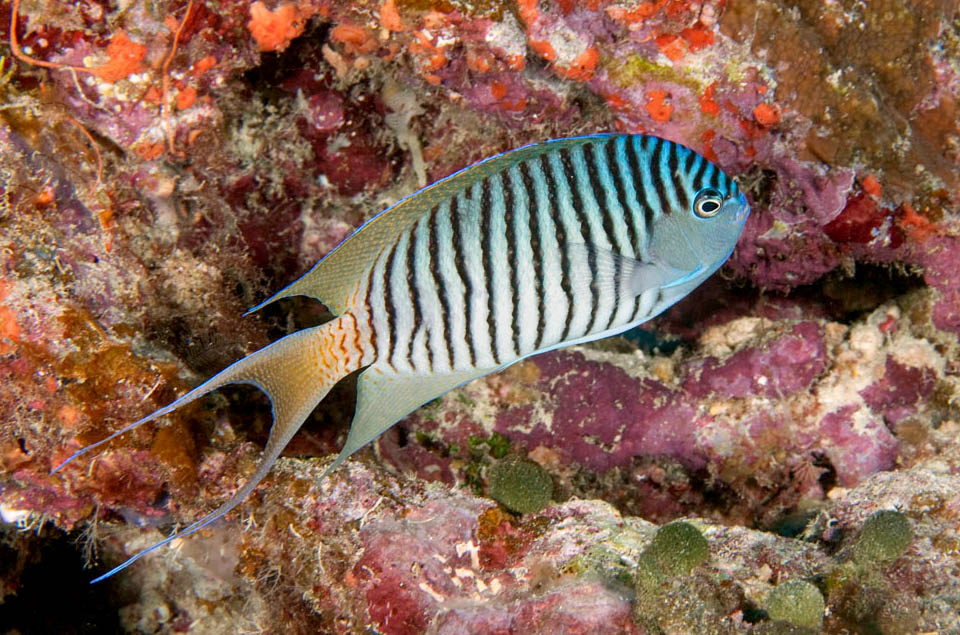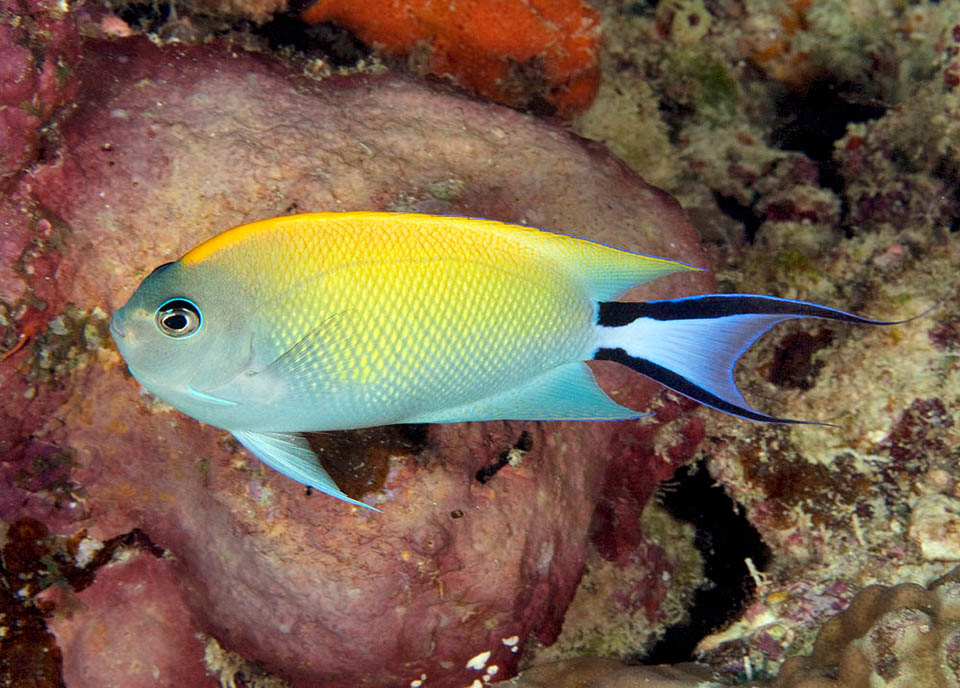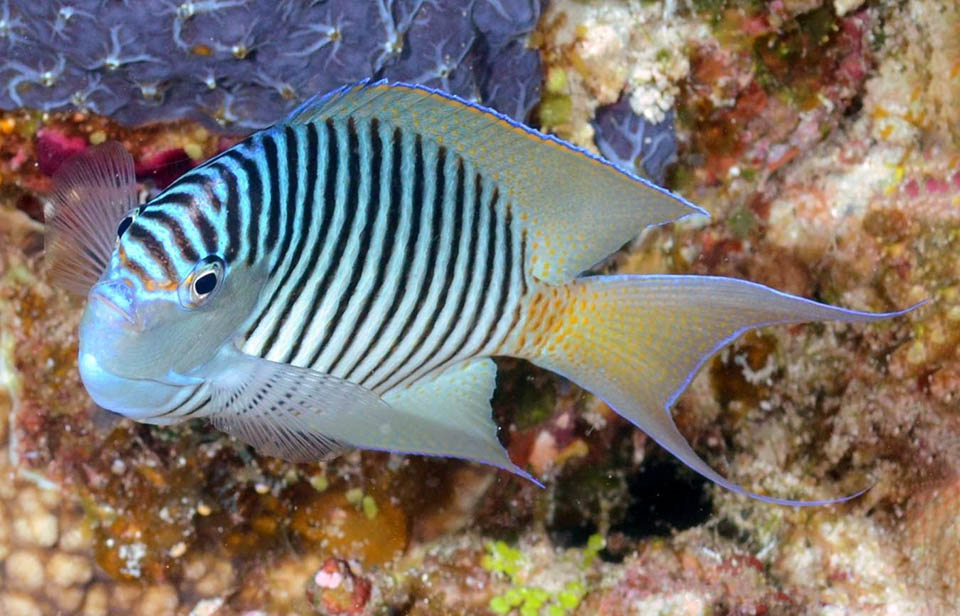Family : Pomacanthidae

Text © Giuseppe Mazza

English translation by Mario Beltramini

Genicanthus melanospilos male. It lives in the tropical waters of western Pacific and Indian Ocean nearby zones © Paddy Ryan
Genicanthus melanospilos (Bleeker 1857), commonly known as Swallowtail angelfish or Spotbreast angelfish, belongs to the class of the Actinopterygii, the ray-finned fishes, to the order Perciformes and to the family of Pomacanthidae, counting 8 genera and about 90 species, often present in the aquaria with their multicoloured liveries.
Very compressed laterally fishes and with a characteristic spine at the base of the preoperculum, present also in the genus Genicanthus that counts about a ten species and comes from the old Greek “γένυς” (genys) = cheek and “ἄκανθα” (akantha) = spine, with reference, rightly, to this peculiarity.
The specific name melanospilos comes, always in ancient Greek, from “μέλαν” (mélan) = black and “σπιλος” (spilos) = spot, to remind the showy black spot that, apart from the lateral bands, the males have ventrally just before the pelvic fins.
Zoogeography
The Spotbreast angelfish has a vast diffusion in the western Pacific Ocean, crossing into the neighbouring areas of the Indian Ocean. Indicatively, starting from Indonesia, it reaches, northwards, China and Japan, southwards, after Australia, New Caledonia. Eastwards, after Papua New Guinea, we find it in Micronesia, the Solomon Islands, Vanuatu and in the Fiji Islands. Recently, it has been found also in Tonga waters.

A female. Apart from the caudal fin elongated in the sides like a swallow tail, as the vulgar name states, the livery is completely different © Paddy Ryan
Ecology-Habitat
Genicanthus melanospilos is a sedentary species, present between 20 and 45 m of depth, strictly linked to the madreporic formations. It loves the external steep slopes of the reefs, rich of protrusions and of grottoes where to hide, but it can be found also on the sandy seabeds, close to coralligenous remains, and usually, looking for food in sites where the currents abound of zooplankton.
Morphophysiology
The males can reach the length of 18 cm. The females are smaller, but can, growing, become males. In fact, as for instance occurs for Genicanthus lamarck and Genicanthus personatus, this is a sequential protogynous hermaphrodite species. In fact, upon birth, the young have both sexes, but the first to manifest is the female one. Then, with age, the females may transform into males and can have a small harem. Usually, they are small groups of 3-7 individuals. When the leader dies, the biggest female turns male and takes its place.
The mouth is small with rows of tiny brush-like teeth. The long dorsal fin has 15 spiny rays and 15-17 soft that extend far beyond the caudal peduncle, like the anal fin, symmetrical at the end, that has 3 spiny rays and 17-18 unarmed. The pectoral caudal is semilunate with very long lobes forming elegant filaments also in the females apart the golden colour of the eyes and the great bluish defensive spine at the base of the preoperculum. The livery displays a strong sexual dimorphism.

It is a sequential protogynous hermaphrodite species. All young are females but growing they can turn into males © Graham Edgar, Reef Life Survey
The males of Genicanthus melanospilos are immediately recognized due to the zebra pattern usually formed by 15 parallel vertical lines on a white-bluish background, paler on the body and dark on the back and towards the head. On the caudal peduncle stands an orange hatch line like the elegant speckling present on the dorsal fin, the anal and the caudal that all end with a thin blue little border. Finally, there is a black spot in the chest, visible only if the fish is observed from below, that has granted the name to the species.
In females the upper part of the body tends to yellow with scales more and more bordered, towards the belly, with the bluish grey that covers the remaining parts of the body. The “swallow tail” of the caudal fin is more emphasized by the bluish strips on the sides, edged with blue.
Liveries that can be found also, roughly, also including the black spot of the males, in a similar species, the Genicanthus caudovittatus, centered however in the Indian Ocean.
Ethology-Reproductive Biology
The Spotbreast angelfish nourishes of zooplankton that often catches, without moving too much, in the water column over the den. When a female is ready for spawning, the fecundation takes place swimming, and the eggs are entrusted to the currents.
The resilience of the species is quite good with a possible doubling of the populations in 1.4-4.4 years, and the Fishing Vulnerability index is very low: just 10 on a scale of 100.
The populations are stable and since 2010 Genicanthus melanospilos has been listed as “LC, Least Concern” in the IUCN Red List of endangered species.
→ For general information about FISH please click here.
→ For general information about BONY FISH please click here
→ For general information about CARTILAGINOUS FISH please click here.
→ To appreciate the BIODIVERSITY of BONY FISH please click here.
→ To appreciate the BIODIVERSITY of CARTILAGINOUS FISH please click here.
